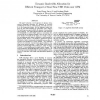Free Online Productivity Tools
i2Speak
i2Symbol
i2OCR
iTex2Img
iWeb2Print
iWeb2Shot
i2Type
iPdf2Split
iPdf2Merge
i2Bopomofo
i2Arabic
i2Style
i2Image
i2PDF
iLatex2Rtf
Sci2ools
INFOCOM
1994
IEEE
1994
IEEE
Dynamic Bandwidth Allocation for Efficient Transport of Real-Time VBR Video over ATM
This pape? presents a novel approach to dynamic transmission bandwidth allocation for transport of real-time variable-bit-rate video in ATM networks. Describe video traffic in the frequency domain: the low frequency signal captures the slow time-variation of consecutive scene changes; the high frequency signal exhibits the feature of strong frame autocorrelation. Our study indicates that the video transmission bandwidth in a finite-buffer system is essentially characterized by the low frequency signal. Since the time scale of scene changes is usually in the range of a second or longer, the low frequency video signal is defined in a well-founded low frequency band. Hence, it is feasible to implement dynamic allocation of video transmission bandwidth using on-line observation and prediction of scene changes. Two prediction schemes are examined: recursive least square method us. time delay neural network method. A time delay neural network with low-complexity high-order architecture, cal...
| Added | 09 Aug 2010 |
| Updated | 09 Aug 2010 |
| Type | Conference |
| Year | 1994 |
| Where | INFOCOM |
| Authors | Song Chong, San-qi Li, Joydeep Ghosh |
Comments (0)

